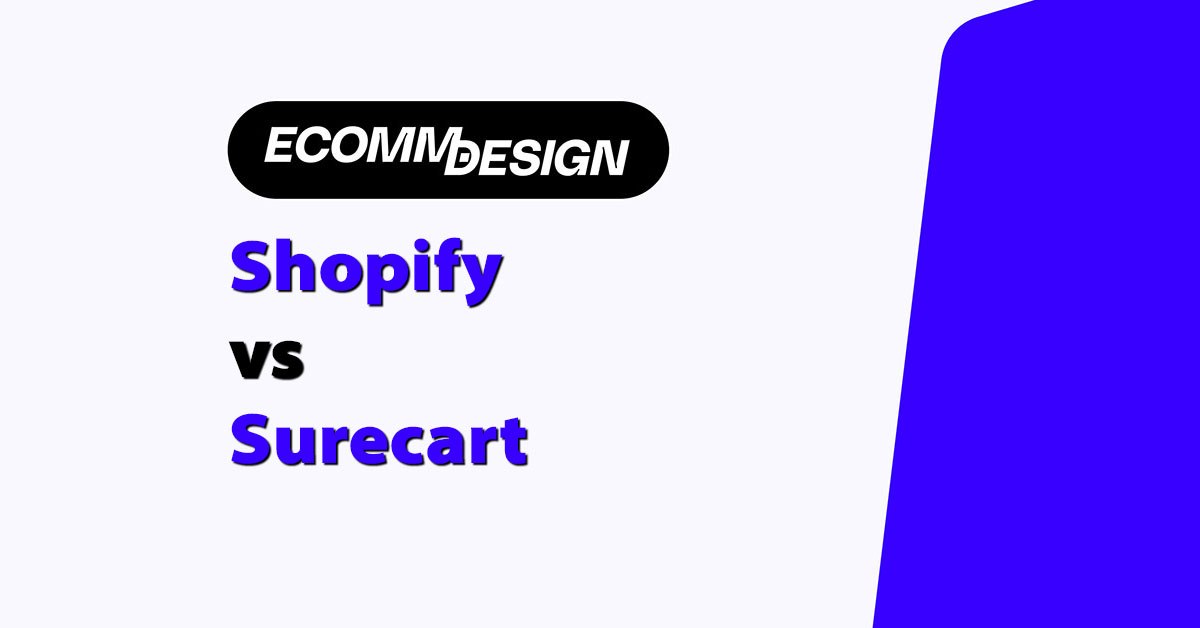
Shopify vs SureCart: Which is better?
The answer might be simpler than you think. Ultimately, if you’re looking for a complete omnichannel commerce solution, Shopify is the platform I’d always recommend. It’s versatile, flexible, and its constantly evolving (it even features some great AI tools).
SureCart, on the other hand, really only makes sense if you want to add ecommerce functionality to an existing WordPress website, and don’t want to deal with the hassle of WooCommerce.
It’s not an all-in-one website builder and ecommerce platform, but it does deliver ecommerce features.
Here’s everything you need to know to make the right choice.
Quick Verdict, Pros and Cons
Shopify and SureCart both allow people to sell products online, but they’re very different tools.
Shopify is a complete website builder and ecommerce platform that combines everything you need to run, market, and grow your business.
SureCart simply adds ecommerce functionality to an existing website, built with WordPress.
Shopify is best for:
Sellers looking for a complete website builder and scalable ecommerce platform with powerful integrations and built-in marketing tools.
SureCart is best for:
WordPress users who want a lightweight, simple way to start selling online without switching platforms or installing WooCommerce.
Shopify Pros and Cons:
Pros:
- Complete website builder and ecommerce platform
- Easy to use environment for business management
- Thousands of integration options
- Powerful AI capabilities and omnichannel selling
- Excellent themes and design tools
- Flexible platform for all kinds of selling
Cons:
- Pricing and transaction fees can be expensive
- Some functionality requires extra apps (like selling digital products)
SureCart Pros and Cons
Pros:
- Instant and easy integration with WordPress
- Customizable checkout forms and payment processing options
- Support for physical and digital product selling
- Lightweight, lightning fast performance
- Easy store management features
- One-click upsells and order bumps
Cons:
- No website builder (only works with WordPress)
- Very basic inventory management
- Limited analytics and reports
Quick Comparison: Shopify vs SureCart
| Feature | Shopify | SureCart |
|---|---|---|
| Overall Rating | 4.8 | 4.2 |
| Starting Price | $5/month (Starter), $39/month (Basic plan) | Free plan available; Paid plans from $39/month |
| Setup Fees | None | None |
| Website Builder | Full drag-and-drop builder included | None – relies on WordPress |
| Ecommerce Features | Advanced tools for inventory, checkout, payments, and sales channels | Core ecommerce features (checkout, subscriptions, cart recovery) |
| Design Tools | 100+ mobile-optimised themes | Not included |
| AI Features | Shopify Magic + Sidekick for automation and content | None |
| App Integrations | 8,000+ apps via Shopify App Store | Integrates with many WordPress plugins |
| Sales Channels | Social, marketplaces, POS, website | Website only (via WordPress) |
| POD/Dropshipping | Yes – via integrations (e.g. Printful, DSers) | Not supported natively |
| Checkout Customisation | Basic (unless on Plus) | Highly customisable |
| Support | 24/7 live chat, email, phone | Email support (priority on paid plans) |
| Free Trial | 3-day free trial + 3 months for $1/month | Free plan available |
| Best For | Businesses of all sizes looking to scale | WordPress users selling digital or physical products |
| Visit | Visit Shopify |
Shopify vs SureCart: Fees and Pricing
Before I cover the features of Shopify and SureCart, and what they do best, let’s discuss pricing. One of the things that makes SureCart so appealing to a lot of sellers, is how affordable it is to use.
If you’re already using WordPress (which you can do for free), you can start selling with SureCart without paying anything extra.
The free plan includes support for selling digital and physical products, subscriptions, and more. It even includes cart abandonment tools, automatic payment recovery, and sales tax calculation tools.
However, you will get SureCart branding on your website.
More advanced plans range from $39 to $69 per month, with extra features like order bumps, one-click upsells, and a custom email address on the cheaper plan, and extra storage, multiple currencies, and affiliate platform support on the more expensive plan.

There’s also a “Scale Lifetime plan” you can get for $1,599 – which gives you all of the features of the platform, forever, for a one-off fee.
Shopify might be a little pricier. You can get started with the Starter plan for $5 per month, but that doesn’t include the website builder, it just allows you to sell on other websites, and through social media.
The Basic plan starts at $39 per month, like SureCart’s first paid plan, but I think it’s better value, since it includes access to Shopify’s website builder.

More advanced plans include Shopify ($105 per month), and Shopify Advanced ($399 per month).
Plus, there’s an Enterprise plan (Shopify Plus), which starts at $2,300 per month. Notably, you will have to pay transaction fees with Shopify, if you’re not using Shopify Payments.
SureCart vs Shopify: Core Features
Since SureCart and Shopify are very different tools, it doesn’t make sense to compare common features like website design tools side by side (SureCart doesn’t have any).
Instead, I’m going to cover the core features of each platform, and what they do best.
SureCart Core Features, and What it Does Best
SureCart is a plugin for WordPress that adds ecommerce functionality to your existing website. It allows you to sell physical and digital products (such as courses and downloads).
You can also sell subscriptions, set up free and paid trials, and automatically recover payments from buyers.
Where it really excels is at giving companies convenient tools they can use to increase conversions. I love the fact that abandoned cart recovery is included on the free SureCart plan (although you will have limitations on how many emails you can send).
Plus, more advanced plans come with access to “order bumps”, and “one-click upsell” options which can help you increase average order values.
Additionally, the plugin is highly lightweight, efficient, and customizable. It allows you to customize checkout forms easily (something that you will struggle to do with Shopify), and can integrate with a host of different tools.
Plus, you can manage everything from within your WordPress dashboard, which does make life a lot easier if you don’t want to jump between different tools and apps.
There’s also included automatic backups and security protocols for peace of mind, and you get basic store management tools, such as tax calculation apps, shipping tools, and inventory and order management features.
Notably, those features aren’t as advanced as the ones you’d get from Shopify, but I think they’re fine for smaller businesses without a huge inventory.
Shopify’s Core Features and What it Does Best
Where SureCart simply plugs ecommerce features into your existing website, Shopify gives you a website builder and commerce platform in one. Unlike SureCart, Shopify allows companies to build a fully branded online store, with convenient themes and design tools.
There are even AI-powered solutions built into the platform that can help you create content for web pages, or manage your inventory more effectively.
Shopify mostly supports physical product sales, but you can sell digital products and subscriptions with add-ons.
Plus, you’ll be able to sell across various channels, such as social media platforms, marketplaces, and even in-person, with Shopify POS.

It has its own integrated payment processor, a world-leading checkout solution, and a host of powerful tools to increase sales.
Shopify includes built-in marketing features like email marketing and promotional tools. It’s also excellent for SEO, with an integrated blog, and the ability to customize title tags and meta descriptions.
However, I do think WordPress is a better option for SEO and marketing overall.
Shopify definitely beats SureCart in terms of analytical tools and business management features.
There are a lot more options for managing orders, inventory, and shipping requirements on Shopify, and you can integrate with more print on demand and dropshipping tools.
Speaking of integrations, Shopify has one of the biggest app markets out there. You can connect thousands of tools to your store, from apps for accounting and website design, to solutions for customer service, and logistics.
Of course, SureCart integrates with a lot of solutions too, as a WordPress plugin.
SureCart vs Shopify: Ease of Use and Customer Support
If you’re looking for an easy-to-use ecommerce option, both Shopify and SureCart are great. SureCart is likely to be the better solution if you’re already using WordPress to manage your online presence, because it connects seamlessly into your WordPress backend.
It also offers fewer features than Shopify overall, so there might be a slightly smaller learning curve from that perspective.
However, I think Shopify is extremely intuitive, particularly now that it has so many AI solutions, like Shopify Magic for content creation, and Shopify Sidekick, to help you run your store on a daily basis.
Shopify beats SureCart in the customer support arena too. You get 24/7 assistance from Shopify via chat, phone, and email, regardless of the plan you choose.
Plus, there are plenty of online resources, like guides, videos, and community forums to check out.
With SureCart, you’re limited to basic email support on the free plan, and priority email support on paid plans.
However, there are still some good guides, FAQs, and how-to articles on the website for beginners. I particularly like the video tutorials.
SureCart vs Shopify: The Verdict
Simply put, Shopify is the better option overall if you want an all-in-one website builder and omnichannel commerce solution.
It’s more powerful, scalable, and flexible than SureCart, and offers more advanced features for inventory management, reporting, and analytics.
SureCart, however, might be a good option if you want an easy way to add ecommerce functionality to your WordPress site, and you want to keep costs low.
It’s a pretty intuitive tool, with a lot of advanced features (like Abandoned Cart Recovery), that won’t cost business owners a fortune.



